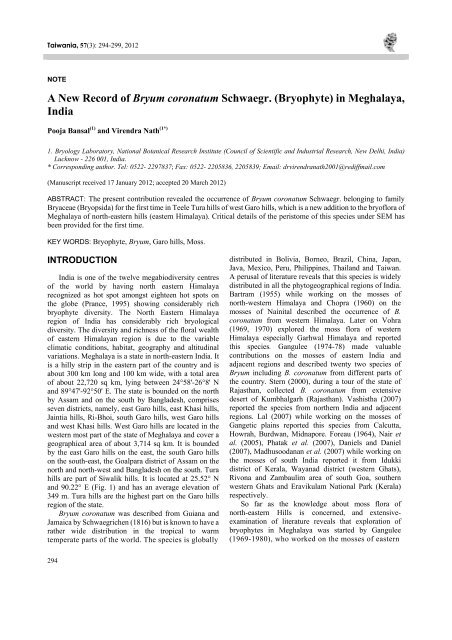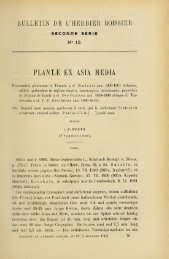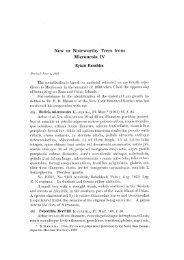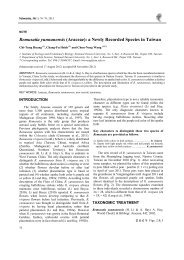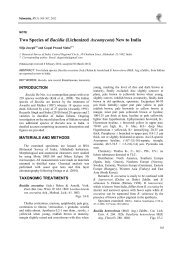A New Record of Bryum coronatum Schwaegr. (Bryophyte) in ...
A New Record of Bryum coronatum Schwaegr. (Bryophyte) in ...
A New Record of Bryum coronatum Schwaegr. (Bryophyte) in ...
Create successful ePaper yourself
Turn your PDF publications into a flip-book with our unique Google optimized e-Paper software.
Taiwania, 57(3): 294-299, 2012<br />
NOTE<br />
A <strong>New</strong> <strong>Record</strong> <strong>of</strong> <strong>Bryum</strong> <strong>coronatum</strong> <strong>Schwaegr</strong>. (<strong>Bryophyte</strong>) <strong>in</strong> Meghalaya,<br />
India<br />
Pooja Bansal (1) and Virendra Nath (1*)<br />
1. Bryology Laboratory, National Botanical Research Institute (Council <strong>of</strong> Scientific and Industrial Research, <strong>New</strong> Delhi, India)<br />
Lucknow - 226 001, India.<br />
* Correspond<strong>in</strong>g author. Tel: 0522- 2297837; Fax: 0522- 2205836, 2205839; Email: drvirendranath2001@rediffmail.com<br />
(Manuscript received 17 January 2012; accepted 20 March 2012)<br />
ABSTRACT: The present contribution revealed the occurrence <strong>of</strong> <strong>Bryum</strong> <strong>coronatum</strong> <strong>Schwaegr</strong>. belong<strong>in</strong>g to family<br />
Bryaceae (Bryopsida) for the first time <strong>in</strong> Teele Tura hills <strong>of</strong> west Garo hills, which is a new addition to the bry<strong>of</strong>lora <strong>of</strong><br />
Meghalaya <strong>of</strong> north-eastern hills (eastern Himalaya). Critical details <strong>of</strong> the peristome <strong>of</strong> this species under SEM has<br />
been provided for the first time.<br />
KEY WORDS: <strong>Bryophyte</strong>, <strong>Bryum</strong>, Garo hills, Moss.<br />
INTRODUCTION<br />
India is one <strong>of</strong> the twelve megabiodiversity centres<br />
<strong>of</strong> the world by hav<strong>in</strong>g north eastern Himalaya<br />
recognized as hot spot amongst eighteen hot spots on<br />
the globe (Prance, 1995) show<strong>in</strong>g considerably rich<br />
bryophyte diversity. The North Eastern Himalaya<br />
region <strong>of</strong> India has considerably rich bryological<br />
diversity. The diversity and richness <strong>of</strong> the floral wealth<br />
<strong>of</strong> eastern Himalayan region is due to the variable<br />
climatic conditions, habitat, geography and altitud<strong>in</strong>al<br />
variations. Meghalaya is a state <strong>in</strong> north-eastern India. It<br />
is a hilly strip <strong>in</strong> the eastern part <strong>of</strong> the country and is<br />
about 300 km long and 100 km wide, with a total area<br />
<strong>of</strong> about 22,720 sq km, ly<strong>in</strong>g between 24°58'-26°8' N<br />
and 89°47'-92°50' E. The state is bounded on the north<br />
by Assam and on the south by Bangladesh, comprises<br />
seven districts, namely, east Garo hills, east Khasi hills,<br />
Ja<strong>in</strong>tia hills, Ri-Bhoi, south Garo hills, west Garo hills<br />
and west Khasi hills. West Garo hills are located <strong>in</strong> the<br />
western most part <strong>of</strong> the state <strong>of</strong> Meghalaya and cover a<br />
geographical area <strong>of</strong> about 3,714 sq km. It is bounded<br />
by the east Garo hills on the east, the south Garo hills<br />
on the south-east, the Goalpara district <strong>of</strong> Assam on the<br />
north and north-west and Bangladesh on the south. Tura<br />
hills are part <strong>of</strong> Siwalik hills. It is located at 25.52° N<br />
and 90.22° E (Fig. 1) and has an average elevation <strong>of</strong><br />
349 m. Tura hills are the highest part on the Garo hills<br />
region <strong>of</strong> the state.<br />
<strong>Bryum</strong> <strong>coronatum</strong> was described from Guiana and<br />
Jamaica by <strong>Schwaegr</strong>ichen (1816) but is known to have a<br />
rather wide distribution <strong>in</strong> the tropical to warm<br />
temperate parts <strong>of</strong> the world. The species is globally<br />
294<br />
distributed <strong>in</strong> Bolivia, Borneo, Brazil, Ch<strong>in</strong>a, Japan,<br />
Java, Mexico, Peru, Philipp<strong>in</strong>es, Thailand and Taiwan.<br />
A perusal <strong>of</strong> literature reveals that this species is widely<br />
distributed <strong>in</strong> all the phytogeographical regions <strong>of</strong> India.<br />
Bartram (1955) while work<strong>in</strong>g on the mosses <strong>of</strong><br />
north-western Himalaya and Chopra (1960) on the<br />
mosses <strong>of</strong> Na<strong>in</strong>ital described the occurrence <strong>of</strong> B.<br />
<strong>coronatum</strong> from western Himalaya. Later on Vohra<br />
(1969, 1970) explored the moss flora <strong>of</strong> western<br />
Himalaya especially Garhwal Himalaya and reported<br />
this species. Gangulee (1974-78) made valuable<br />
contributions on the mosses <strong>of</strong> eastern India and<br />
adjacent regions and described twenty two species <strong>of</strong><br />
<strong>Bryum</strong> <strong>in</strong>clud<strong>in</strong>g B. <strong>coronatum</strong> from different parts <strong>of</strong><br />
the country. Stern (2000), dur<strong>in</strong>g a tour <strong>of</strong> the state <strong>of</strong><br />
Rajasthan, collected B. <strong>coronatum</strong> from extensive<br />
desert <strong>of</strong> Kumbhalgarh (Rajasthan). Vashistha (2007)<br />
reported the species from northern India and adjacent<br />
regions. Lal (2007) while work<strong>in</strong>g on the mosses <strong>of</strong><br />
Gangetic pla<strong>in</strong>s reported this species from Calcutta,<br />
Howrah, Burdwan, Midnapore. Foreau (1964), Nair et<br />
al. (2005), Phatak et al. (2007), Daniels and Daniel<br />
(2007), Madhusoodanan et al. (2007) while work<strong>in</strong>g on<br />
the mosses <strong>of</strong> south India reported it from Idukki<br />
district <strong>of</strong> Kerala, Wayanad district (western Ghats),<br />
Rivona and Zambaulim area <strong>of</strong> south Goa, southern<br />
western Ghats and Eravikulam National Park (Kerala)<br />
respectively.<br />
So far as the knowledge about moss flora <strong>of</strong><br />
north-eastern Hills is concerned, and extensiveexam<strong>in</strong>ation<br />
<strong>of</strong> literature reveals that exploration <strong>of</strong><br />
bryophytes <strong>in</strong> Meghalaya was started by Gangulee<br />
(1969-1980), who worked on the mosses <strong>of</strong> eastern
September, 2012 Bansal and Nath: A new record <strong>of</strong> <strong>Bryum</strong> <strong>coronatum</strong> from India<br />
Fig. 1. Map show<strong>in</strong>g distribution <strong>of</strong> <strong>Bryum</strong> <strong>coronatum</strong> <strong>in</strong> Tura, West Garo hills<br />
India and adjacent regions and reported 248 species <strong>of</strong><br />
mosses belong<strong>in</strong>g to 120 genera from different parts <strong>of</strong><br />
Meghalaya, ma<strong>in</strong>ly from Khasia hills. He reported<br />
<strong>Bryum</strong> argenteum, <strong>Bryum</strong> medianum, <strong>Bryum</strong><br />
caespiticium, <strong>Bryum</strong> alp<strong>in</strong>um, <strong>Bryum</strong> porphyroneuron<br />
and <strong>Bryum</strong> paradoxum from Khasia hills, but there is no<br />
record <strong>of</strong> B. <strong>coronatum</strong> from Meghalaya (west Garo<br />
hills) previously. Recently dur<strong>in</strong>g monographic studies<br />
on Indian taxa <strong>of</strong> the genus <strong>Bryum</strong> Hedw., some plants<br />
collected from Teele Tura hills <strong>of</strong> west Garo become a<br />
new record species for Meghalaya.<br />
MATERIALS AND METHODS<br />
The study is based on the specimens available at the<br />
<strong>Bryophyte</strong> Herbarium <strong>of</strong> the National Botanical<br />
Research Institute, Lucknow (India) and were earlier<br />
collected from the forest <strong>of</strong> Teele Tura hills, west Garo,<br />
at an average height <strong>of</strong> 410 m above sea level dur<strong>in</strong>g<br />
September, 1999.<br />
TAXONOMIC TREATMENT<br />
<strong>Bryum</strong> <strong>coronatum</strong> <strong>Schwaegr</strong>. Sp. Musc. Frond., Suppl.<br />
1(2): 103. pl. 71. 1816. Fig. 2<br />
Plants very small, closely tufted, bright-dull green to<br />
yellowish-green above, dark brown below and <strong>in</strong> lower<br />
part matted with brown radicles, tomentose at base,<br />
rarely up to ±2 cm high. Stems slender, short, more or<br />
less erect, green, becom<strong>in</strong>g reddish or brownish <strong>in</strong> lower<br />
portions, branched from base. Leaves numerous, more<br />
crowded and closer <strong>in</strong> the upper portion <strong>of</strong> stem, more<br />
distant below, erect to erectopatent, not greatly<br />
contorted when dry, slightly decurrent, 1.8-2.8 × 1.2-1.4<br />
mm, imbricate, ovate to oblong-lanceolate, sharply<br />
acum<strong>in</strong>ate; marg<strong>in</strong>s entire, flat; costa strong, red to<br />
reddish-brown, long excurrent <strong>in</strong> a ±0.5 mm long<br />
slightly denticulate arista; apical lam<strong>in</strong>al cells th<strong>in</strong> to<br />
thick walled, narrowly hexagonal-rhomboidal, ±55-65 ×<br />
7-12 µm, narrower towards marg<strong>in</strong> but without any<br />
clearly def<strong>in</strong>ed border, median lam<strong>in</strong>al cells narrowly<br />
295
296<br />
Taiwania Vol. 57, No. 3<br />
Fig. 2. Morphology <strong>of</strong> <strong>Bryum</strong> <strong>coronatum</strong> <strong>Schwaegr</strong>. A-B: Plants. C: Cross-section <strong>of</strong> stem. D-I: Leaves. J: Apical lam<strong>in</strong>al cells.<br />
K: Middle lam<strong>in</strong>al cells. L: Basal lam<strong>in</strong>al cells. M: Cross-section <strong>of</strong> leaf. N: Enlarged view <strong>of</strong> capsule. O: Cross-section <strong>of</strong> seta.<br />
P: Peristome teeth. Q: Spores.
September, 2012 Bansal and Nath: A new record <strong>of</strong> <strong>Bryum</strong> <strong>coronatum</strong> from India<br />
rhombic to elongate-hexagonal, 30-60 × 9-16 µm,<br />
th<strong>in</strong>-walled, basal lam<strong>in</strong>al cells broad and<br />
short-rectangular, th<strong>in</strong> walled, 35-45 × 15-22 µm. Seta<br />
slender, flexuose, apical, erect but arcuate at tip, 20-25<br />
mm long, reddish-brown. Capsule thick, cyl<strong>in</strong>drical,<br />
<strong>in</strong>cl<strong>in</strong>ed to pendulous, dark red when mature, shaped<br />
like a cup <strong>in</strong> another cup with a short rounded neck,<br />
2.0-2.5 mm long with the thick spongy apophysis;<br />
operculum convex-conical, apiculate with sharp po<strong>in</strong>t,<br />
shortly rostrate, dark red when mature; annulus present,<br />
with thick walled, irregular shaped, slightly elongated<br />
exothecial cells; peristome well developed, <strong>in</strong>serted<br />
close to mouth <strong>of</strong> capsule, exostome teeth dark<br />
brown-yellow, broad lanceolate, narrow<strong>in</strong>g abruptly<br />
above <strong>in</strong>to slender light coloured, hyal<strong>in</strong>e, papillose<br />
apex, ±500 µm long, endostome transparent yellow,<br />
papillose, basal membrane high with 2 to 3<br />
appendiculate cilia. Spores small, yellow, nearly smooth<br />
to m<strong>in</strong>utely papillose, 8-9 µm <strong>in</strong> diameter.<br />
Spore under SEM: Spore spherical to semispherical,<br />
8-9 µm <strong>in</strong> diameter, yellowish green with regularly<br />
arranged short bacculate process, bacculae 0.3-0.4 µm<br />
high, depression on dorsal surface (Fig 3. A-B).<br />
Peristome under SEM: Exostomial teeth<br />
conspicuously papillose via presence <strong>of</strong> prom<strong>in</strong>ent<br />
papillae on the ventral surface thus formed reticulate<br />
pattern <strong>of</strong> ornamentation on the dorsal surface (Fig 3.<br />
C-D).<br />
Specimen exam<strong>in</strong>ed: INDIA: Eastern Himalaya,<br />
Meghalaya, west Garo Hills, Forest Teele Tura Hills, alt. ca 410 m,<br />
on rocky soil near road, 19.09.1999 Leg.: A.P. S<strong>in</strong>gh and M. Lal,<br />
208101 (LWG).<br />
DISCUSSION<br />
<strong>Bryum</strong> <strong>coronatum</strong> <strong>Schwaegr</strong>. is a light green plant.<br />
Among the Indian species <strong>of</strong> <strong>Bryum</strong>, sterile plant <strong>of</strong> B.<br />
<strong>coronatum</strong> is more likely to be mistaken with B.<br />
caespiticium. but the latter can be easily recognized <strong>in</strong><br />
hav<strong>in</strong>g erect-erectopatent, oblong to ovate-lanceolate<br />
leaves with strongly revolute marg<strong>in</strong> all along the length,<br />
costa excurrent with 0.2 mm long arista contrast<strong>in</strong>g the<br />
former by leaves be<strong>in</strong>g ovate to oblong-lanceolate,<br />
sharply acum<strong>in</strong>ate with entire, flat marg<strong>in</strong>s, costa more<br />
long excurrent <strong>in</strong> a ±0.5 mm long slightly denticulate<br />
arista. The species is also confused with B. bicolor <strong>in</strong><br />
most <strong>of</strong> the morphological (vegetative) features, but can<br />
be dist<strong>in</strong>guished by leaf shape and excurrency <strong>of</strong> costa.<br />
B. bicolor have concave leaves with excurrent costa and<br />
the bulbils have thick, triangular primordia with costa<br />
whereas B. <strong>coronatum</strong> leaves are relatively short and<br />
broad and gemmae are usually absent. A unique feature<br />
is the presence <strong>of</strong> capsule which shape like a cup <strong>in</strong><br />
another cup along with strongly thickened apophysis<br />
which is almost <strong>in</strong>flated and dist<strong>in</strong>ctly rugose where-as<br />
capsule <strong>of</strong> B. bicolor is hemisphaerical to ovoid and<br />
apophysis is less thickened and more or less smooth.<br />
An <strong>in</strong>terest<strong>in</strong>g feature <strong>of</strong> this plant is that quite unlike<br />
most mosses <strong>of</strong>ten affected by environmental changes, it<br />
persists <strong>in</strong> habitats with<strong>in</strong> heavily populated human<br />
settlements irrespective <strong>of</strong> <strong>in</strong>dustrial emissions and its<br />
community is not easily amenable to decomposition after<br />
the completion <strong>of</strong> its annual growth cycle. The presence<br />
<strong>of</strong> B. <strong>coronatum</strong> <strong>in</strong> Meghalaya has further widened its<br />
range <strong>of</strong> distribution to eastern Himalayan region <strong>of</strong><br />
India.<br />
ACKNOWLEDGEMENTS<br />
Thanks are due to the Director, National Botanical<br />
Research Institute, Lucknow (India) for provid<strong>in</strong>g facilities and<br />
Council <strong>of</strong> Scientific and Industrial Research, <strong>New</strong> Delhi for<br />
f<strong>in</strong>ancial support.<br />
LITERATURE CITED<br />
Bartram, E. B. 1955. North-western Himalayan mosses. Bull.<br />
Torrey Bot. Cl. 82: 22-29.<br />
Chopra, N. 1960. Mosses <strong>of</strong> Na<strong>in</strong>ital (Himalayas, India). J.<br />
Hatt. Bot. Lab. 23: 80-84.<br />
Daniels, A. E. D. and P. Daniel. 2007. The mosses <strong>of</strong> the<br />
Southern Western Ghats. In: Nath, V. and A. K. Asthana<br />
(eds.) Current trends <strong>in</strong> Bryology, pp. 227-243. Bishen<br />
S<strong>in</strong>gh Mahendra Pal S<strong>in</strong>gh, Dehra Dun.<br />
Foreau, G. 1964. Some South Indian mosses. J. Bom. Nat.<br />
Hist. Soc. 61: 223-226.<br />
Gangulee, H. C. 1969-72. Mosses <strong>of</strong> Eastern India and<br />
Adjacent Regions, pp. 1-830. Vol. I. Books and Allied (P)<br />
Ltd., Kolkata, India.<br />
Gangulee, H. C. 1974-78. Mosses <strong>of</strong> Eastern India and<br />
Adjacent Regions, pp. 831-1546. Vol. II. Books and<br />
Allied (P) Ltd., Kolkata, India.<br />
Gangulee, H. C. 1978-80. Mosses <strong>of</strong> Eastern India and<br />
Adjacent Regions, pp. 1547-2145. Vol. III. Books and<br />
Allied (P) Ltd., Kolkata, India.<br />
Lal, J. 2007. Mosses <strong>of</strong> Gangetic Pla<strong>in</strong>s - a neglected<br />
biogeographic zone <strong>of</strong> India. In: Nath, V. and A. K.<br />
Asthana (eds.) Current trends <strong>in</strong> Bryology, pp. 131-147.<br />
Bishen S<strong>in</strong>gh Mahendra Pal S<strong>in</strong>gh, Dehra Dun.<br />
Madhusoodanan, P. V., M. C. Nair and P. S. Easa. 2007.<br />
Diversity <strong>of</strong> bryophytes <strong>in</strong> Eravikulam National Park,<br />
Kerala (South India). In: Nath, V. and A. K. Asthana<br />
(eds.) Current trends <strong>in</strong> Bryology, pp. 255-267. Bishen<br />
S<strong>in</strong>gh Mahendra Pal S<strong>in</strong>gh, Dehra Dun.<br />
Nair, M. C., K. P. Rajesh and P. V. Madhusoodanan. 2005.<br />
<strong>Bryophyte</strong>s <strong>of</strong> Wayanad <strong>in</strong> Western Ghats, pp. 125-131.<br />
Malabar Natural History Society (MNHS), Kerala, India.<br />
Phatak, S., M. N. Vijayan and C. Samuel. 2007.<br />
Biodiversity and distribution <strong>of</strong> bryophytes <strong>of</strong> Goa- A<br />
prelim<strong>in</strong>ary study. In: Nath, V. and A. K. Asthana (eds.)<br />
Current trends <strong>in</strong> Bryology, pp. 149-160. Bishen S<strong>in</strong>gh<br />
Mahendra Pal S<strong>in</strong>gh, Dehra Dun.<br />
Prance, G. T. 1995. Biodiversity. Encyclopedia <strong>of</strong><br />
Environmental Biology 1: 183-192.<br />
297
298<br />
Taiwania Vol. 57, No. 3<br />
Fig. 3. A. Sporoderm pattern <strong>of</strong> <strong>Bryum</strong> <strong>coronatum</strong>, B. Enlarged view <strong>of</strong> a portion <strong>of</strong> spore. C. Exostome and endostome<br />
under SEM, D. Enlarged view <strong>of</strong> a portion <strong>of</strong> exostome.<br />
<strong>Schwaegr</strong>ichen, F. 1816. Species Muscorum Frondosorum,<br />
Descriptae et Tabvlis Aeneis coloratis illvstratae, Opus<br />
Postumum. Supplementum Primum Scriptum. Leipzig,<br />
Germany, Suppl. 1(II): 103.<br />
Stern, R. C. 2000. Some <strong>Bryophyte</strong>s collected <strong>in</strong> Rajasthan.<br />
J. Bryol. 22: 298-299.<br />
Vashistha, B. D. 2007. Mosses <strong>of</strong> Pla<strong>in</strong>s <strong>of</strong> Northern India<br />
and adjacent regions. In: Nath, V. and A. K. Asthana<br />
(eds.) Current trends <strong>in</strong> Bryology, pp. 177-187. Bishen<br />
S<strong>in</strong>gh Mahendra Pal S<strong>in</strong>gh, Dehra Dun.<br />
Vohra, J. N. 1969. A contribution to the moss flora <strong>of</strong><br />
Western Himalaya I. Bull. Bot. Surv. India. 11: 41-50.
September, 2012 Bansal and Nath: A new record <strong>of</strong> <strong>Bryum</strong> <strong>coronatum</strong> from India<br />
Vohra, J. N. 1970. A contribution to the moss flora <strong>of</strong><br />
Western Himalaya II. Bull. Bot. Surv. India. 12: 97-103.<br />
蕊形真蘚在印度梅加拉亞邦的新紀錄分佈<br />
Pooja Bansal (1) and Virendra Nath (1*)<br />
1. Bryology Laboratory, National Botanical Research Institute (Council <strong>of</strong> Scientific and Industrial Research, <strong>New</strong> Delhi, India)<br />
Lucknow - 226 001, India.<br />
* 通信作者。Tel: 0522- 2297837; Fax: 0522- 2205836, 2205839; Email: drvirendranath2001@rediffmail.com<br />
(收稿日期:2012 年 1 月 17 日;接受日期:2012 年 3 月 20 日)<br />
摘要:本文首次報導蕊形真蘚 (蘚綱:真蘚科) 在印度西加羅丘陵的堤里圖拉嶺之新紀錄分<br />
佈,此新記錄的發現也為梅加拉亞邦的苔蘚植物誌增添新的一頁。本文也首次提出此物種<br />
蒴齒在電子顯微鏡下的細節。<br />
關鍵詞:蘚苔植物、真蘚屬、加羅丘陵、蘚類。<br />
299


